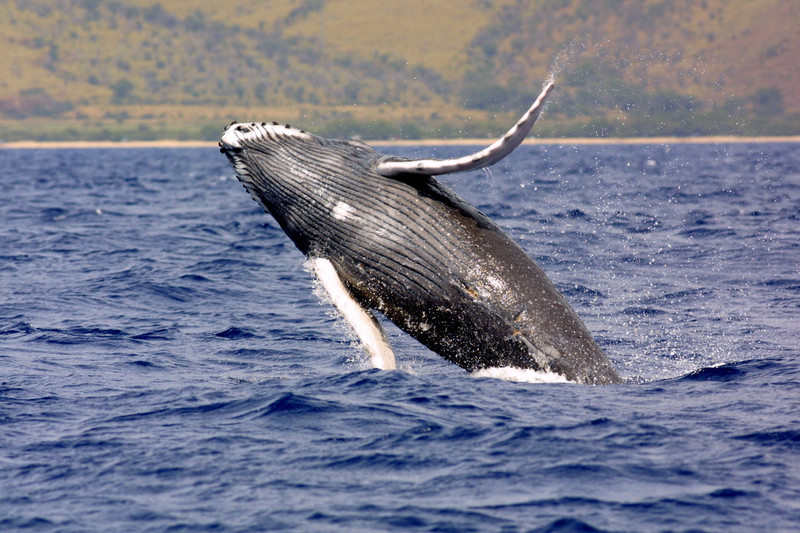For Immediate Release, April 20, 2021
|
Contact: |
Todd Steiner, Turtle Island Restoration Network, (415) 488-7652, tsteiner@seaturtles.org Catherine Kilduff, Center for Biological Diversity, (530) 304-7258, ckilduff@biologicaldiversity.org Luhui Isha, Wishtoyo Foundation, (805) 729-7692, luhuiisha@wishtoyo.org |
Biden Administration Protects Endangered Pacific Humpback Whale Habitat
Final Rule Designates 116,098 Square Nautical Miles as Critical Habitat
SAN FRANCISCO—The Biden administration issued a final rule today protecting 116,098 square nautical miles of the Pacific Ocean as critical habitat for three populations of endangered humpback whales. The rule could begin to help protect migrating whales from ship strikes, entanglement in fishing gear, and oil spills.
The action was prompted by a 2018 legal victory by the Center for Biological Diversity, Wishtoyo Foundation and Turtle Island Restoration Network. The groups had sued over the federal failure to designate critical habitat as required by the Endangered Species Act. The suit led the Trump administration to issue a proposed rule in 2019 and today’s final rule.
“Today is a good day for humpback whales and the ocean all living things depend on,” said Todd Steiner, executive director of Turtle Island Restoration Network. “Designating 116,000 square miles of critical habitat in the ocean is something to celebrate, but whales, turtles and dolphins still need additional protection from industrial fishing and ship strikes to recover and thrive, so we won’t be resting on our laurels.”
The biggest threats in humpback habitat are ships and fishing gear. The Center sued the federal government in January for failing to protect endangered whales from speeding ships using California ports. The organization is also co-sponsoring the California Whale Entanglement Prevention Act (Assembly Bill 534), which would require the state’s commercial Dungeness crab and other trap fisheries to convert to ropeless gear (also known as “on-demand” or “pop-up buoy” gear) by the end of 2025.
One population of endangered humpback whales that feeds off California’s coast contains fewer than 800 individuals, leaving them vulnerable to threats from humans. Today’s rule designates a total of 224,030 square nautical miles for the two endangered and one threatened populations, but overlapping habitat means 116,098 square nautical miles will be protected.
The rule designates 48,521 square nautical miles of critical habitat off the coast of California, Oregon and Washington for the humpback population that winters in Central America. The Mexico population got 116,098 square nautical miles in the North Pacific Ocean, including Bering Sea and Gulf of Alaska — regions that also made up the 59,411 square nautical miles listed for the Western North Pacific humpback population.
“Pacific humpbacks finally got the habitat protections they’ve needed for so long. Now we need to better protect humpbacks from ship strikes and entanglement in fishing gear, their leading causes of death,” said Catherine Kilduff, an attorney with the Center. “To recover West Coast populations of these playful, majestic whales, we need mandatory ship speed limits and conversion of California’s deadly trap fisheries to ropeless gear.”
Critical habitat protection will help safeguard ocean areas essential for migrating and feeding. The designation will ensure that federally permitted activities do not destroy or harm important whale habitat. Evidence shows that endangered or threatened species that have protected critical habitat are twice as likely to be recovering as those without it.

Turtle Island Restoration Network is a global nonprofit whose mission is to inspire and mobilize people around the world to protect marine biodiversity and the oceans that sustain all life on Earth.
The Center for Biological Diversity is a national, nonprofit conservation organization with more than 1.7 million members and online activists dedicated to the protection of endangered species and wild places.
Founded in 1997, Wishtoyo Foundation is a 501(c)(3) nonprofit grassroots organization that enhances the well being of communities by preserving and protecting Chumash Native American culture, and the natural resources all people depend upon throughout California and the traditional Chumash range in Ventura, Los Angeles, Santa Barbara and San Luis Obispo counties. To learn more about Wishtoyo visit us at www.wishtoyo.org.




